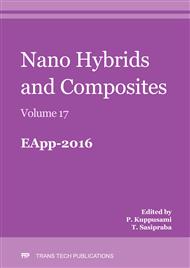[1]
Elena V Timofeeva, David S Smith, Wenhua Yu, David M France, Dileep SinghandJules L Routbort, Particle size and interfacial effects on thermo-physical and heat transfer characteristics of water-based α-SiC nanofluids. IOP Publishing Ltd, Nanotechnology, 21 (2010).
DOI: 10.1088/0957-4484/21/21/215703
Google Scholar
[2]
Pramod Warrier, A. T. Effect of particle size on the thermal conductivity of nanofluids containing metallic nanoparticles. Nanoscale Research Letters, 6 (2011) 247.
DOI: 10.1186/1556-276x-6-247
Google Scholar
[3]
Fang, D. L. Preparation and stability of silver/kerosene. Nanoscale Research Letters, 7 (2012) 362.
Google Scholar
[4]
Sayantan Mukherjee, S. P. Preparation and Stability of Nanofluids-. IOSR Journal of Mechanical and Civil Engineering (IOSR-JMCE) 9 2 (2013) 63-69.
DOI: 10.9790/1684-0926369
Google Scholar
[5]
Dan Li, Wenjie Xie, Wenjun Fang, Preparation and properties of copper-oil-based nanofluids, Nanoscale Research Letters, 6 (2011) 1.
Google Scholar
[6]
Totten, George E., S. R. Westbrook, and R. J. Shah. Fuels and lubricants handbook: technology, properties, performance, and testing. Training 2007 (2003) 08-21.
DOI: 10.1520/mnl37wcd-eb
Google Scholar
[7]
C.T. Nguyen, F. Desgranges, N. Galanis, T. Mare, S. Boucher, H.A. Mintsa, Viscosity data for Al2O3ewater nanofluid-hysteresis: is heat transfer enhancement using nanofluids reliable International Journal of Thermal Sciences 47 (2008) 111-103.
DOI: 10.1016/j.ijthermalsci.2007.01.033
Google Scholar
[8]
Godson L, Lal DM, Wongwises S. Measurement of thermo physical properties of metallic nanofluids for high temperature applications. Nanoscale Microscale Thermophys Eng. 14 2010 152–173.
DOI: 10.1080/15567265.2010.500319
Google Scholar
[9]
S. Sonawane, K. Patankar, A. Fogla, B. Puranik, U. Bhandarakar, S. Sunil Kumar, An experimental investigation of thermo-physical properties and heat transfer performance of Al2O3-aviation turbine fuel nanofluids, Applied Thermal Engineering 31 (2011).
DOI: 10.1016/j.applthermaleng.2011.05.009
Google Scholar
[10]
Godson L, Raja B, Lal DM, Wongwises S. Enhancement of heat transfer using nanofluids an overview. Renew Sustain Energy Rev. 14 (2010) 629.
DOI: 10.1016/j.rser.2009.10.004
Google Scholar
[11]
Vasheghani M, Marzbanrad E, Zamani C, Aminy M, Raissi B, Ebadzadeh T, Bafrooei HB. Effect of Al2O3 phases on the enhancement of thermal conductivity and viscosity of nanofluids in engine oil. Heat Mass Transf. 47 (2011) 1401.
DOI: 10.1007/s00231-011-0806-8
Google Scholar
[12]
Zhu DS, Wu SY, Wang N. Surface tension and viscosity of aluminum oxide nanofluids. In: Proceedings of 6th international symposium on multiphase flow, heat mass transfer and energy conversion, 460 (2009) 11–15.
Google Scholar
[13]
Godson L, Raja B, Raj V, Lal DM. Measurement of viscosity and surface tension of silver deionized water nanofluids. In: Proceedings of 37th national & 4th international conference on fluid mechanics and fluid power, vol. no. 2010, December 16–18, IIT Madras, Chennai, India; (2010).
Google Scholar
[14]
J.H. Lee, K.S. Hwang, S.P. Jang, B.H. Lee, J.H. Kim, S.U.S. Choi, C.J. Choi, Effective viscosities and thermal conductivities of aqueous nanofluids containing low volume concentrations of Al2O3 nanoparticles, International Journal of Heat and Mass Transfer, 51 (2008).
DOI: 10.1016/j.ijheatmasstransfer.2007.10.026
Google Scholar
[15]
Godson L, Deepak K, Enoch C, Jefferson B, Raja B. Heat transfer characteristics of silver/water nanofluids in a shell and tube heat exchanger. Arch Civil Mech Eng. 14 2014 489–96.
DOI: 10.1016/j.acme.2013.08.002
Google Scholar
[16]
Y.S. Ju, J. Kim, Ming-Tsung Hung, Experimental study of heat conduction in aqueous suspensions of aluminum oxide nanoparticles, Journal of Heat Transfer 130 (2008) 1-6.
DOI: 10.1115/1.2945886
Google Scholar
[17]
Tan, E. S., Idris, M. A., Anwar, M., & Adnan, R. Biodiesel for Gas Turbine Application-An Atomization Characteristics Study. INTECH Open Access Publisher (2013).
DOI: 10.5772/54154
Google Scholar
[18]
Emmanuel. R, Summertime Urban Heat Island Mitigation: Propositions based on an investigation of Intra-Urban air temperature variations, Architectural Science Review, 40 4 (2000).
DOI: 10.1080/00038628.1997.9696826
Google Scholar
[19]
P.C. Mukesh Kumar, J. Kumar, Review on Nanofluid Theoretical Viscosity Models, International Journal of Engineering Innovation & Research, 1, Issue 2, ISSN : 2277 – 5668.
Google Scholar
[20]
Deepak Kumar Agarwal, Aravind Vaidyanathan, S. Sunil Kumar, Synthesis and characterization of kerosene alumina nanofluids". Applied Thermal Engineering 60 (2013) 25-284.
DOI: 10.1016/j.applthermaleng.2013.06.049
Google Scholar


